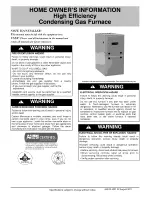
5894307-UIM-B-0920
Johnson Controls Ducted Systems
19
VENT SYSTEM
Install this furnace using one of the following vent configurations:
• Horizontal vent system. This vent system can be installed com-
pletely horizontal or combinations of horizontal, vertical, or offset
using elbows.
• Vertical vent system. This vent system can be installed com-
pletely vertical or a combination of horizontal, vertical, or offset
using elbows.
VENT APPLICATIONS AND TERMINATION
When selecting the location for a combustion air/vent termination, con-
sider the following:
• Observe all clearances listed in the VENT CLEARANCES section
in these instructions.
• Termination must be positioned where vent vapors do not dam-
age plants, shrubs, or air conditioning equipment.
• Termination must be located where it is not affected by wind
gusts, light snow, or airborne leaves and does not allow recircula-
tion of flue gases.
• Termination must be located where it is not subject to damage or
exposure to flying stones and balls.
• Termination must be positioned where vent vapors are not objec-
tionable.
• Horizontal portions of the vent system must slope upwards and
be supported to prevent sagging.
• Direct vent systems must be installed so the vent and the com-
bustion air pipes terminate in the same atmospheric zone. See
Figures 21 and 22.
VENTING MULTIPLE UNITS
Multiple units can be installed in a space or structure as either a single-
pipe configuration or a two-pipe configuration.
The combustion air side of the single-pipe configuration shown in Fig-
ures 20 and 28 is referred to in these instructions as ambient combus-
tion air supply. Follow the instructions for ambient combustion air
installations, paying particular attention to the information on air source
from inside the building in the Ambient Combustion Air Supply section.
The vent for a single-pipe system must be installed as specified in the
VENT APPLICATIONS AND TERMINATION section with both vents
terminating as shown in Figures 23 to 24. Each furnace must have a
separate vent pipe. Under NO circumstances can the two vent pipes be
tied together.
The combustion air side of the two-pipe configuration shown in Figures
23 and 24 can be installed so the combustion air pipe terminates as
described in the Outdoor Combustion Air section or the Ventilated Com-
bustion Air section. Follow the instructions for outdoor combustion air or
ventilated combustion air and the instructions for installing the vent sys-
tem with the vent terminating as shown in Figures 23 and 24. The two-
pipe system must have a separate combustion air pipe and a separate
vent pipe for each furnace. Under NO circumstances can the two com-
bustion air or vent pipes be tied together. The combustion air and vent
pipes must terminate in the same atmospheric zone.
Figure 20:
Termination Configuration - 1 Pipe
WARNING
Condensation in Intake Pipe
Installations where the furnace and intake pipe are to be located in a
conditioned space and in a region that may have hot, humid weather
extending several consecutive days will have condensate form in the
intake pipe. Use of the supplied intake drain will ensure that any con-
densate will be safely diverted away from the internal components of
the furnace. Proper venting installation (of both intake and exhaust)
and sealing any equipment air leaks that might contact the intake pipe
will help reduce condensation.
12” Min.
12” Min.
Maintain 12” minimum clearance
above highest anticipated snow level.
Maximum 24” above roof.
!
Figure 21:
Termination Configuration - 2 Pipe
Figure 22:
Termination Configuration - 2 Pipe Basement
Maintain 12” minimum
clearance above
highest anticipated
snow level.
12” vertical separation
between combustion air
intake and vent.
12” minimum
below overhang
12” minimum
separation between
bottom of
combustion air pipe
and bottom of vent.
Maintain 12”
minimum clearance
above highest
anticipated snow
level or grade,
whichever is higher.
12” MIN.
12” MIN.
OVERHANG
12” Minimum
below overhang
12” Minimum
separation between
bottom of
combustion air
intake and
bottom of vent
Maintain 12”
minimumclearance
above highest
anticipated snow
level or grade,
whichever is higher













































